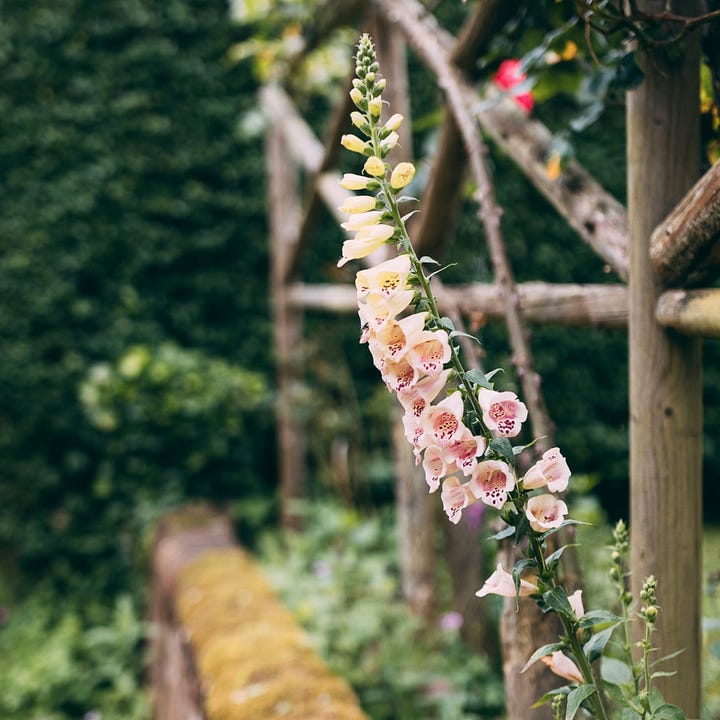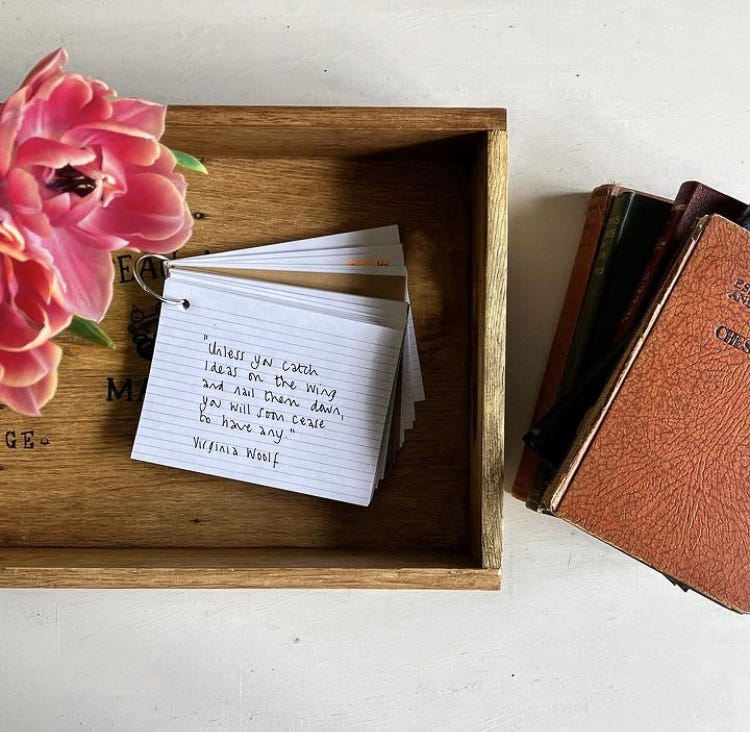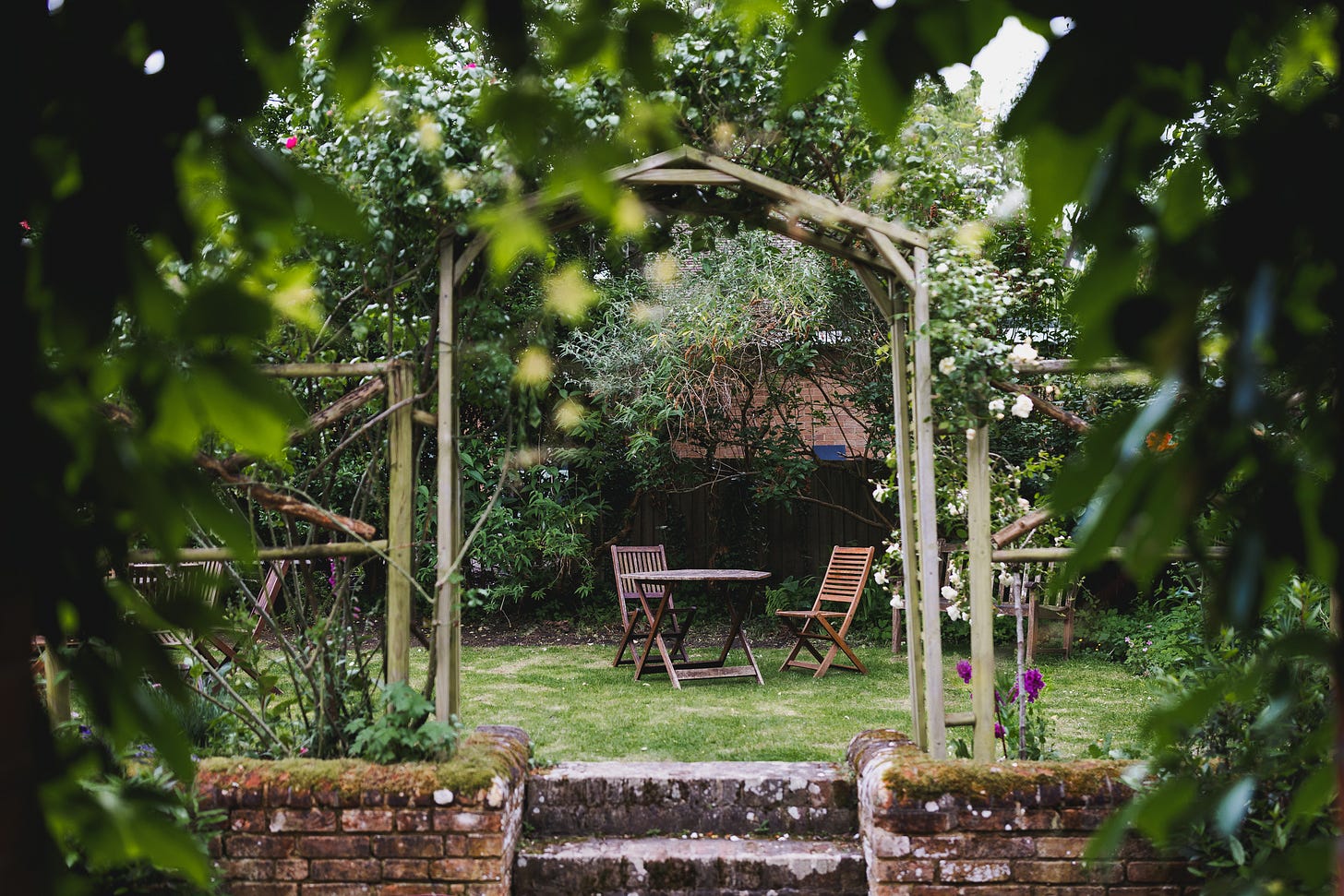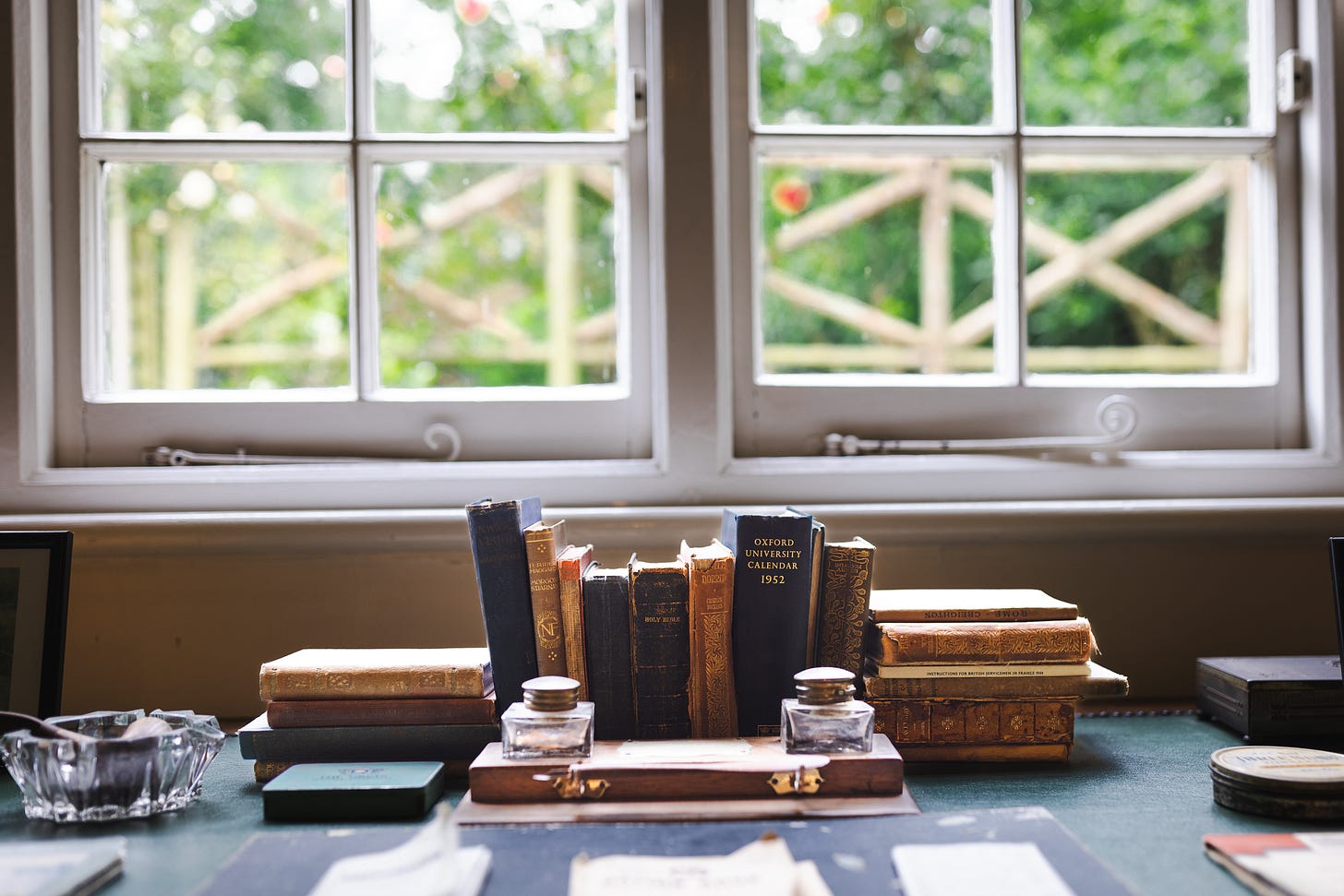The Art of Commonplacing: An Interview with Leah Boden
on the history of commonplacing, how to get started, finding consistency in the practice, and commonplacing as a legacy
A couple of years ago, I was taking a photography course and the instructor shared a quote that moved me deeply. There’s a quality of writing that becomes art. Like a good song, it goes beyond the intellect. It moves our spirit. We feel its resonance in our bodies.
For years, I had heard of the practice of commonplacing. It’s easy to get caught up in all of the trappings of any new interest and sometimes that can hold us back. Maybe I needed a special journal and fancy pens for such an endeavor. But I decided to start with what I had: a spiral notebook with a kraft cardboard cover and a brown pen. I even crossed out a word using circular scribbles on the opening page. If I was going to do this, it needed to be accessible, not so pristine that I was afraid to make a mistake. (Though I have since invested in some good old-fashioned White Out and am contemplating using it on that opening page as I type this.)
Two years later, this notebook is half-filled with words that comforted, guided, and inspired me through various joys and obstacles in my life. Many came exactly in the moment I needed them. I am so glad I opened up my simple spiral notebook and started writing.
Leah Boden and I met in 2017 at a homeschooling event and ended up collaborating on projects together for years. I took photos that were paired with her beautiful writing, and a deep friendship developed out of that connection. Leah has been studying the pedagogy of Charlotte Mason since 2006 and has taken all four of her children through a Charlotte Mason-inspired education at home. She is the author of the book Modern Miss Mason and has created a community called The Collective, where she offers support to parents looking to go deeper with the Charlotte Mason method of living and learning. Leah has over two decades of experience in the art of commonplacing and her work inspired me to join in on this ancient practice.
Leah, how would you describe a commonplace book to someone who has never heard of it before?
A commonplace book is like a personal anthology or scrapbook of ideas. It's a curated collection of quotes, thoughts, insights, and passages that resonate with you, all gathered together in one place. Think of it as a treasure trove of inspiration and wisdom that you can draw from for your own writing, creative projects, or simply for personal growth and enrichment.
I first learned about commonplacing through you and other Charlotte Mason educators, so I thought it originated with Charlotte Mason. But you shared with me that the practice is much older. Can you tell us a little more about the history of commonplacing?
This practice has ancient roots dating back thousands of years. In those times, one popular approach was creating what was known as a florilegium, a Latin term that literally translates to "a gathering of flowers." Isn't that a lovely image?
Scholars would meticulously curate passages from various writings – religious texts, philosophical works, classical literature – carefully selecting the excerpts that represented the most brilliant ideas and thought-provoking insights to them. It was like arranging a bouquet by hand-picking the most vibrant and fragrant blooms.
By compiling their favourite excerpts into a single anthology, these florilegia allowed them to preserve and share these "flowers of wisdom" plucked from across the intellectual canon. It was a way to exchange and discuss these concentrated kernels of knowledge with others – an early form of remixing and propagating interesting concepts.
While our modern modes of information sharing look quite different, that fundamental desire to collect, curate, and disseminate meaningful ideas has endured. These historical florilegia were simply predecessors to our current practice of sharing quotes, passages, and insights that resonate with us personally and intellectually.
So, in many ways, keeping a commonplace book allows us to continue this rich tradition of "gathering flowers" – creating our own curated collections of inspiration and wisdom to draw from and let bloom into our own original works.


It’s incredible how a desire to preserve and share the words that stir us has existed across time, uniting us with people who lived long before us in our shared humanity.
I’d love to know how you got started with commonplacing.
I've always been a lover of quotes, words of wisdom, and excerpts from books, poems, or plays. I used to write them on post-it notes or scraps of paper and keep them in books or stick them on my wall nearby where I was working or sleeping! Our lives can be transformed by a word spoken or read at the right time. I am moved, comforted, and changed by words, so I naturally became a collector of them.
I learnt about commonplacing in the early 2000s as I began my home-educating journey. At the same time, I was learning about Charlotte Mason's teaching that we all have a "mind gallery", and as we pay attention to the world and glean knowledge for ourselves, we store it up in our personal mind galleries to be used at the appropriate time.
I'm amazed at how time and time again, when I'll be in a situation, see a particular landscape or scene in nature, or be in the middle of a conversation, a quote, saying, or piece of wisdom I'd learnt years ago will pop into the forefront of my mind and need to be shared!
Early this year, in spring, I opened our front door to the park we live near, and a glorious mist was rising from the field in front of our house. I immediately spoke out, "seasons of mist and mellow fruitfulness", which is a quote from a Keats poem (about Autumn), but that's what this scene brought to mind.
This is so inspiring! I recently read Dorothy Sayer’s The Mind of the Maker. Her perspective was that a demand for originality is a modern notion. She wrote, “The traditional view is that each new work should be a fresh focus of power through which the former streams of beauty, emotion, and reflection are directed.” Your experience with Keats’ poem reminds me of this.
I have often heard commonplacing described as a practice, and any practice involves consistency or habit. I think a lot of people are drawn to the idea of curating a collection of meaningful quotes, but it can feel daunting. How have you maintained consistency in your own commonplace practice?
I began my commonplace habit by writing quotes from my reading, things I heard people say, or parts of poems I loved in a notebook. I didn't have any particular system to it, but as it grew, I loved to flick through and re-read the beauty within the pages.
As an avid reader, some of my favourite commonplace entries start out on the printed page. Whenever I'm really into a book that speaks to me, I keep a pencil handy to underline or highlight the passages that just grab me. These are the lines that make me stop and linger, the beautiful phrases that spark a deep realisation or stir up a longing inside.
Once I've finished the book, I'll take some quiet time to go back over those underlined bits with fresh eyes. I'll carefully reread them, letting the words wash over me again. Certain quotes always rise to the top as the most poignant ones - the ones containing a truth or insight that feels so vital, I know I need to hold onto it.
That's when I'll pull out my commonplace book and transcribe the chosen excerpts with pen and ink. As I hand-write each one, the process becomes almost meditative.
When I have conversations about commonplacing with people, they wonder how to keep it all organized. They might begin by jotting down quotes in different notebooks, possibly based on categories or themes. But, they say this can feel a bit chaotic as they try to keep track of several journals floating around. Do you suggest keeping everything in a single notebook? And do you have a system for cataloging your quotes?
I actually prefer a bit of a chaotic mass of words in a notebook – I'm probably not the woman to speak to if people want to categorise, colour-code, or use washi tape in their commonplace journal (wink). I have notebooks, digital notes, post-it notes on walls, and index cards with a ring so they can flip over and be displayed – these all form my commonplace practice right now.
The beauty of a commonplace book is that it's a deeply personal collection, and there's no one-size-fits-all approach. Some people thrive with a more organised system, while others, like myself, find joy in the serendipitous discovery of quotes and insights scattered throughout the pages.
One of the beautiful aspects of commonplacing is the ability to surround ourselves with the quotes and insights that nourish our souls, much like we would display a vase of freshly picked wildflowers to brighten our living spaces. As an "out of sight, out of mind" person, I've found that having a visible and ever-changing display of my collected wisdom is crucial for keeping these ideas alive and present in my daily life.
One practice that has worked wonderfully for me is using a stack of index cards as a rotating commonplace display. Each day, I'll flip over a new card, revealing a different quote or passage that immediately catches my eye and sparks my imagination. These simple cards become like little vases, each holding a single "flower" of wisdom plucked from the depths of my commonplace collection.
The beauty of this approach is its simplicity and flexibility. The cards can be arranged on a desk, propped up on a windowsill, or even clipped to a small stand – wherever your eye is naturally drawn throughout the day. And with just a quick flip, an entirely new burst of inspiration is presented, keeping the display fresh and engaging.
Many of us can appreciate the process of taking pen to paper in this digital world. It requires us to slow down and stay with each word as we write it. It's therapeutic to be present with these thoughts in a physical way. But some people like the option of also having a digital way of commonplacing. Can you tell us about your experience with that?
I do both. I love the slowed-down action of writing – I think we connect better with the words, and it can be a form of narration (telling back/remembering), which enables the wisdom and knowledge a better chance of lodging itself in our "mind gallery".
I have notebooks and index cards, but I also use Apple Notes to copy and paste quotes I find while scrolling and reading on my phone. Having a digital option allows me to capture those fleeting moments of inspiration whenever and wherever they strike.
Two years ago, I shared about starting my own commonplace book. Several people reached out to me and told me that their grandmothers had had these journals, which became family heirlooms. Through the commonplace book, they got a glimpse into the inner life of someone so dear to them. This got me thinking about commonplacing as a legacy.
Yes, unlike a journal, which many people wouldn't want anyone else to see, a commonplace book is a treasure that can definitely be passed down to younger generations. It offers a unique window into the mind and soul of a loved one, revealing the ideas, quotes, and insights that shaped their worldview and inspired them throughout their life.
Imagine the gift of being able to hold in your hands a physical manifestation of your grandmother or great-grandfather's intellectual and soul filled journey, carefully curated and preserved in their own handwriting. It's a tangible connection to their inner world, a way to keep their wisdom and perspective alive for generations to come.
Leah, this idea deeply speaks to me. We enter into this stream that Dorothy Sayers mentioned by recording ideas written by others. They become a part of us, shaping our way of experiencing the world. These words can then be passed along to our children, grandchildren, and great-grandchildren as they experience “a new fresh focus of power,” perhaps offering them strength, inspiration, or comfort when they need it. So, the stream begins in the past and extends into the future.
What is making you come alive right now outside of commonplacing?
I'm in the midst of writing three fictionalised biographies for middle-grade age children, which will be published next year. I'm coming alive from learning about other people's lives, digging deep into what made them tick, their challenges and successes, what their friends thought of them, and how they were remembered. This is so important and has made me reflect on my own life and legacy.
Researching and crafting these biographical stories has been an incredibly enriching experience. It's a reminder that every life is a tapestry woven with unique experiences, triumphs, and struggles – and by preserving these stories, we honour the human experience in all its complexity and beauty.
All of the photos in this post, with the exception of the first one, were taken on Dan and my 20th anniversary trip to England, where we spent three days adventuring with Leah Boden and her husband Dave. The first three photos are from CS Lewis’s home, the Kilns. The next was taken at the Bodleian Library. The final photo is from Addison’s Walk on the grounds of Magdalen College, Oxford.
Other Interviews in this Series:
Establishing a Home Life Rhythm: An Interview with Jennifer Pepito
An Interview with Flower Farmer Sarah Davis









What a beautiful interview and concept! Thanks so much for sharing this! Some of these words just might make it into my own commonplace journal :)